What Can I Use Instead Of Turpentine For Oil Painting
If y'all paint in oils, you will need solvents to thin your paints and mediums. You volition also need oil painting solvents to make clean your brushes and palette. However if you've browsed through the Solvents section at Jacksonsart.com yous will have realised in that location are a lot to cull from! So which should yous use? In this post I will explicate what you lot need to know almost White Spirit, Turpentine and Citrus-based solvents.
What is the Divergence Between Oil Painting Solvents: White Spirit and Turpentine?
Turpentine is made of the natural resin extracted from trees, and white spirit is made of petroleum distillate. White Spirit tends to be less flammable and less toxic than turpentine. But what does this mean for you lot and your oil painting?
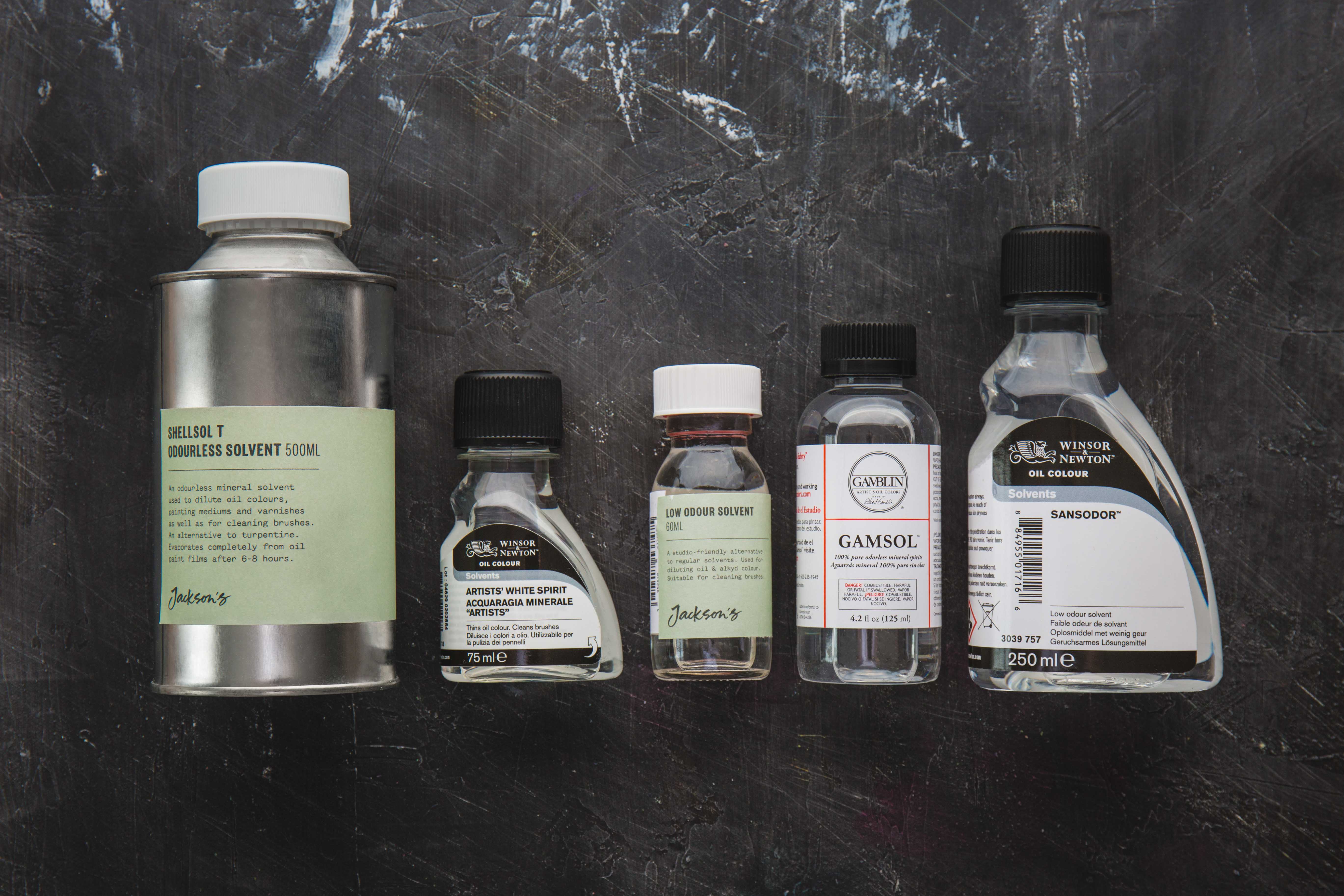
(L-R) Shellsol T, Winsor & Newton Artist White Spirit, Low Odour Solvent, Gamsol and Sansodor – all petroleum distillate based solvents
A Guide to White Spirit
White Spirit is known past a number of names. In the The states/Canada it is almost commonly known every bit Mineral Spirits. In Australia and New Zealand it is known as Mineral Turpentine. Turpentine Substitute, Petroleum Spirits and Paint Thinner are some other names for White Spirit. If yous come across a solvent that has the give-and-take 'mineral' in its name, it is virtually probable to exist a form of white spirit.
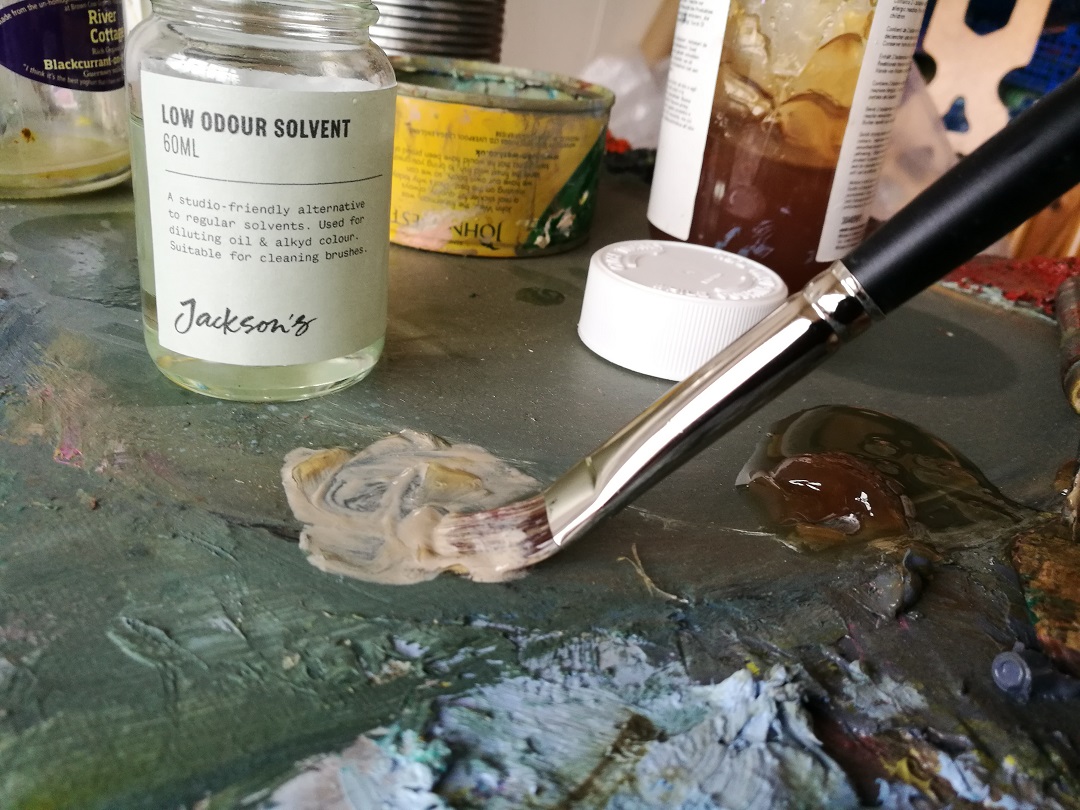
If you're sensitive to fumes, utilise Low Odour Solvent. Perfect for thinning paints mixed with Alkyd paint mediums such equally Liquin.
The Down-sides of Using White Spirit
White Spirit tin have a strong smell and cause dizziness or nausea. Always utilize white spirit in a well ventilated room. If you use information technology for a long fourth dimension or regularly it can cause contact dermatitis. Nitrile gloves or barrier cream tin help with avoiding skin irritation, otherwise simply avert direct contact where possible.
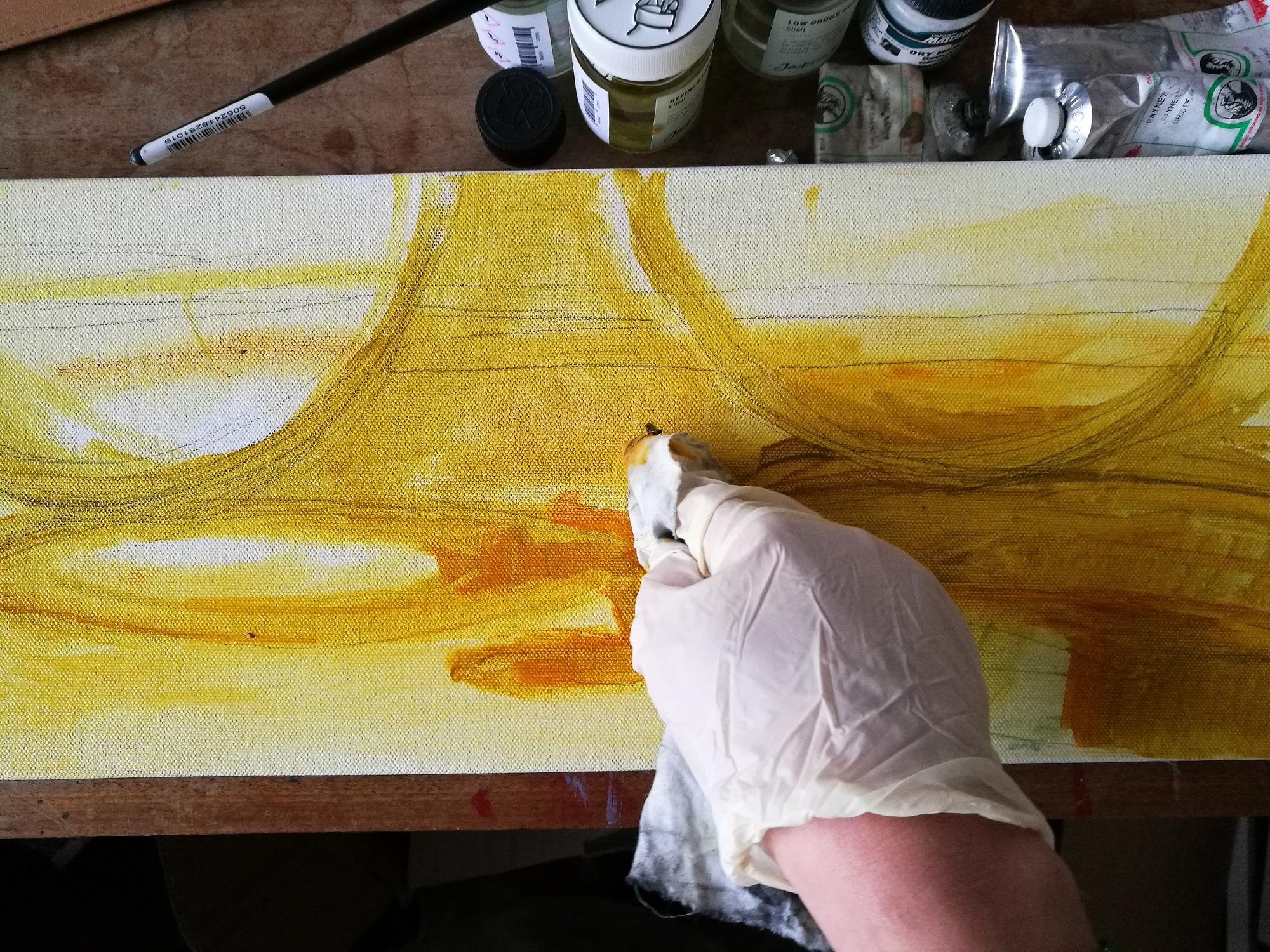
Latex Gloves – at my final painting session I tried these latex gloves and they were surprisingly breathable and comfortable to clothing! Wearing these gloves certainly beats the dry pare that I would otherwise become handling paints (click the image to view the gloves at jacksonsart.com). NB Latex gloves only protect with light utilise and Nitrile gloves are more resistant to solvents.
Can I Use White Spirit From the DIY Store for my Oil Painting Needs?
In a word, no. Household white spirit (from a DIY store) has more impurities than Artist's White Spirit, and should exist kept away from your oil paintings. It will incorporate more impurities such as residuum sulfur, and this makes it much less creative person-friendly. Use Artist'due south White Spirit – it is gratuitous from residuum sulfur, and won't contribute to any deterioration in your work over time.
What Is Low Odour Solvent?
Low Aroma solvent (a.thou.a. Odourless Mineral Spirits) white spirit that has been refined further to remove toxic effluvious compounds. You lot should utilise low odour solvent over regular white spirit if you regularly come up into close contact with your solvent. While Creative person's White Spirit can be used to make clean oil painting brushes, we would advise using low smell White Spirits such as Gamsol, Low Smell Solvent, Shellsol T and Sansodor in painting mediums.
Petroleum distillates will not dissolve natural resins such as dammar, copal or mastic, but it will dissolve alkyd resins. Therefore use low odour solvent to thin Oil, Alkyd paints and alkyd mediums, but non varnishes or any mediums (such equally glaze mediums) that contain natural resins.
If you've browsed the solvents on Jacksonsart.com and want to know what MSA Solvent is for… Golden MSA Solvent is a specialist White Spirit formulated to thin Golden's MSA Varnish; I've not tried it to sparse oil paint but if you lot have we'd love to hear how it performed.
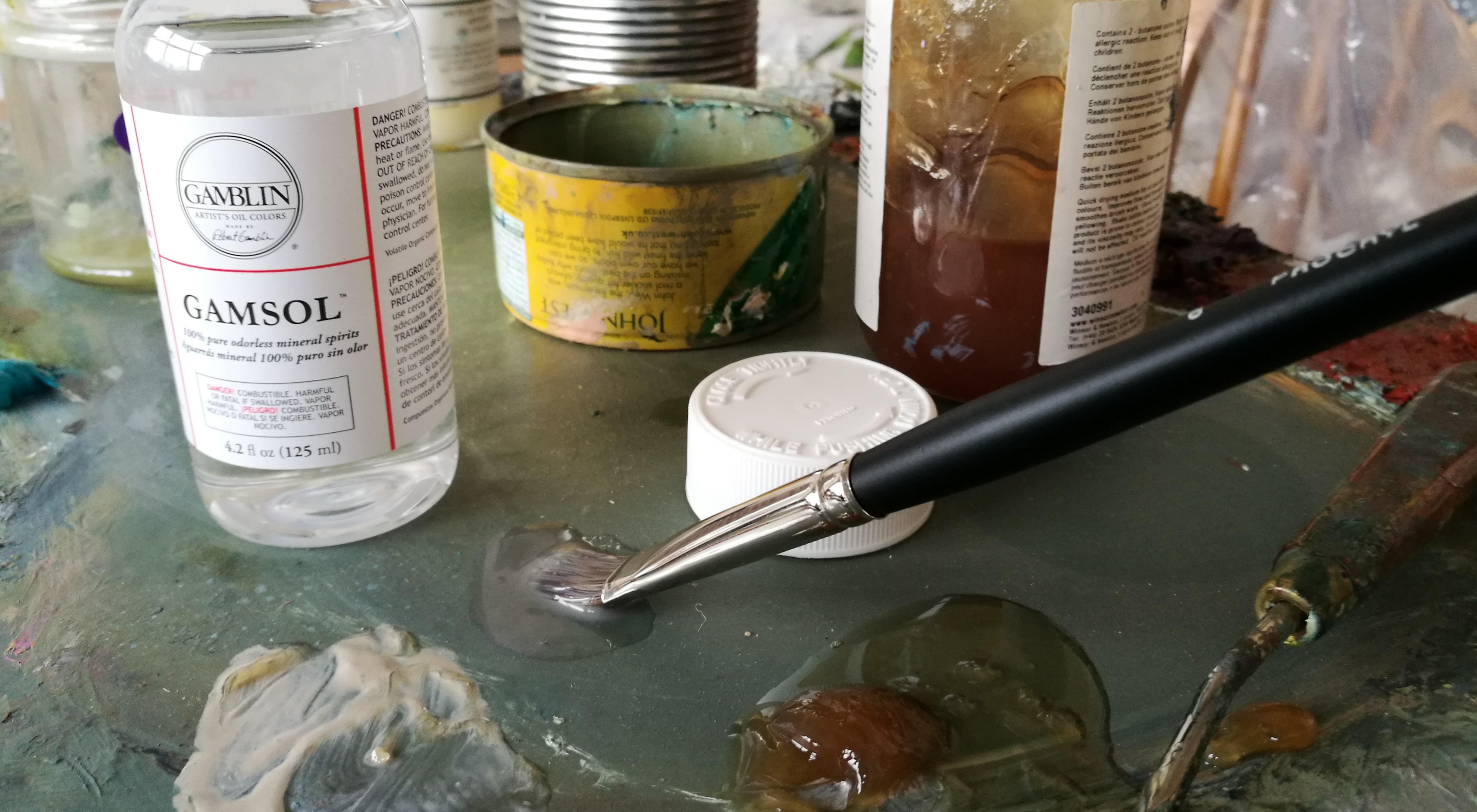
Gamsol has and so little odour for a white spirit. Information technology's definitely worth the actress investment if you are sensitive to fumes. And it volition thin Alkyd better than turpentine and turpentine alternatives.
Summary:
- Avoid using household White Spirit in your Studio
- Creative person's White Spirit is great for cleaning palette and brushes after an oil painting session
- Use the most refined/lowest odour White Spirits, i.due east. Gamsol (often identified every bit the best), Shellsol, Low Aroma Solvent and Sansodor to thin oil pigment, linseed oil and oil paint mediums that already contain petroleum distillates (eastward.g. Alkyd mediums such as Liquin and Galkyd). Drying time aprroximately 6-8 hours
- Petroleum Distillates volition not dilute natural resins such equally Copal, Dammar or Mastic
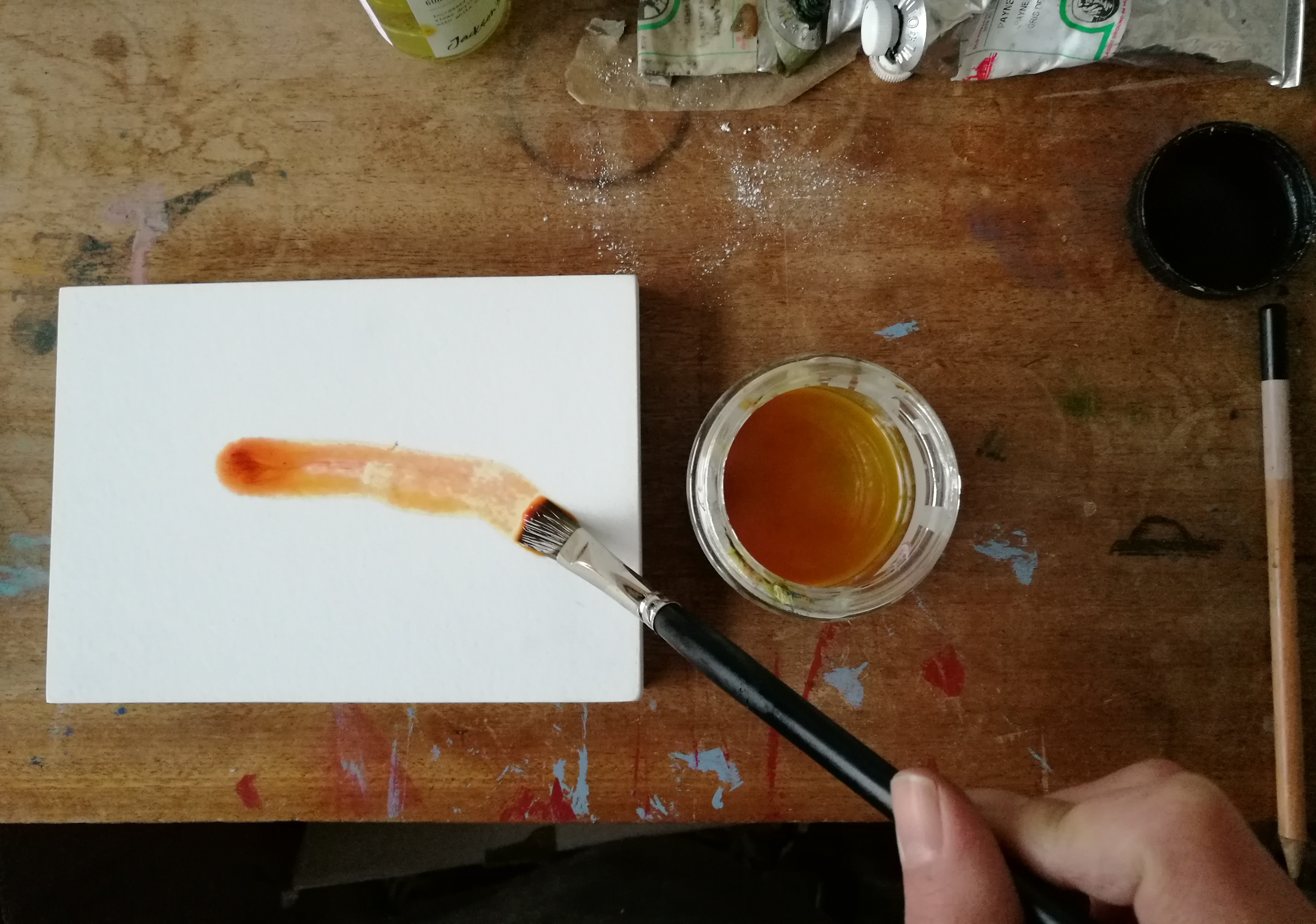
Applying oil paint to a gesso panel, thinned downwardly with English Distilled Turpentine.
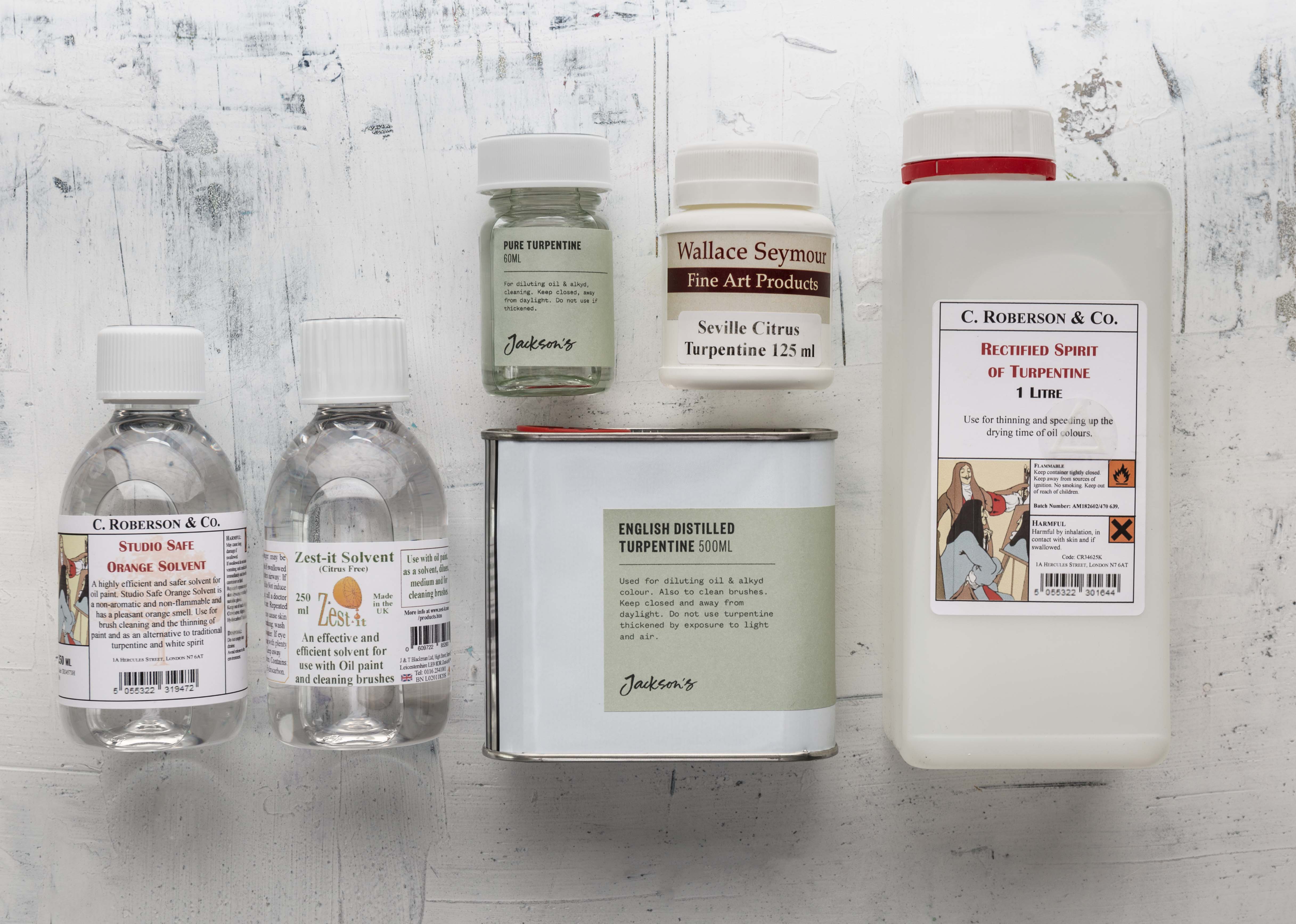
(L – R) Roberson Studio Safe Orange Solvent, Zest-It Solvent, Jackson's Pure Turpentine, Jackson'due south English Distilled Turpentine, Wallace Seymour Seville Citrus Turpentine, Roberson Rectified Spirit of Turpentine.
A Guide to Turpentine as an Oil Painting Solvent
Y'all might hear turpentine being called Spirit of Turpentine or Oil of Turpentine, but information technology's all the same stuff. It is slightly more pasty than white spirit. Good quality turpentine will aroma of the pine trees used to make it. To make turpentine, turpentiners remove the bark of the tree which causes it to secrete oleoresin on to the surface of its wound. The raw oleoresin is then purified using a distillation process, carried out in a copper nonetheless.
Turpentine is flammable and emits vapours that tin irritate the peel and eyes and damage the lungs. Don't utilise Household turps for art – it is likely to exit a gum residue that may prevent your painting from fully drying or crusade yellowing to occur over time. Utilize Artist'due south Turpentine instead. It has far fewer impurities and as a result volition perform better, dry faster and will not xanthous.
Apply Rectified Spirit of Turpentine for An Effective Turpentine with a Pleasant Scent
The highest quality turpentine (east.m. Rectified Spirit of Turpentine) is made solely from the resin of Pine copse which gives it a clean, pleasant odour. Conversely, the forest waste used to make lower quality turpentine gives information technology a bad smell! Although it is possible to purify low class turpentine plenty to make information technology suitable for oil painting, it volition always take a less than pleasant smell.
Larch Venice Turpentine – An Oil Painting Medium, not a Brush Cleaner
Larch Venice Turpentine is a professional class painting medium which is not suited to thinning paints and cleaning brushes. Collected from the heart of the larch tree, it is a highly glutinous balsam. Information technology is free from abietic acrid crystals which tin cause discolouration. Larch Venice Turpentine volition not cause yellowing and dries with an enamel-similar gloss. It is tiresome drying, thixotropic, and is a wonderful ingredient for glaze mediums and varnishes. Place Larch Venice Turpentine in a Bain Marie or dilute it with high quality distilled turpentine to make information technology more fluid.
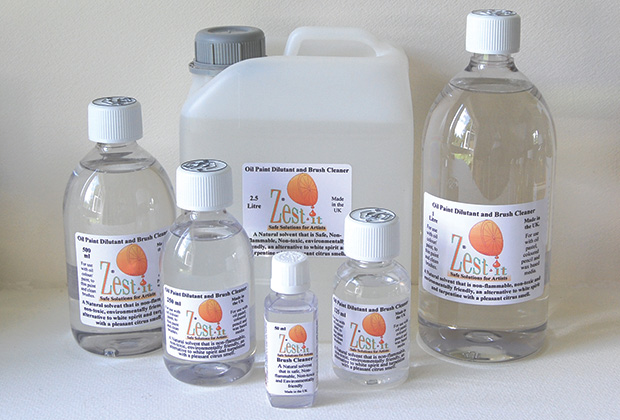
Zest It Solvent and Cleaners
In that location are now a number of Citrus-scented turpentines available. These include Zest-It, Seville Citrus Turpentine and Studio Safe Orange Solvent. Citrus turpentines are non combustible and non aromatic. They are more closer to turpentine than Petroleum Distillate as they will dilute natural resins such as Copal, Mastic and Dammar. They will non get out any rest and are a bully solvent to utilize both in cleaning up and thinning oil paints and mediums.
Summary:
- Turpentine is flammable and is stronger than most Petroleum Distillates
- Do not utilize Household Turpentine in your art studio every bit information technology is likely to exit a rest in painting mediums and cause yellowing over fourth dimension.
- The highest course turpentine has a pleasant pine fragrance (see Rectified Spirit of Turpentine)
- Triple Distilled turpentine will dry more quickly, evenly, and will not leave a rest. Pure Turpentine is ordinarily only singularly distilled and and so is best left for cleaning brushes and palettes just.
- Utilize turpentine with and in Glaze Mediums and Varnish, every bit information technology will dilute natural resins such as Copal, Dammar and Mastic
- Do non use turpentine to thin Alkyd paints and mediums such every bit Liquin or Galkyd
- Turpentine will thicken when exposed to air – do not use thickened turps and always proceed in an air-tight container
- Citrus based Solvents such as Zest-It, Studio Safe Orange Solvent and Citrus Turpentine are non combustible and not aromatic. As a result they emit hardly whatever exciting fumes and tend to be kinder to skin as well. They are too suitable for use in painting mediums.
Further Reading
- Solvent Safety Guide
- Sally Hirst Compares Cold Wax Mediums
- How to Care for a Wooden Oil Painting Palette
What Can I Use Instead Of Turpentine For Oil Painting,
Source: https://www.jacksonsart.com/blog/2018/04/17/oil-painting-solvents/
Posted by: nicholstheacce.blogspot.com


0 Response to "What Can I Use Instead Of Turpentine For Oil Painting"
Post a Comment